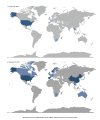Early Detection and Surveillance of the SARS-CoV-2 Variant BA.2.86 - Worldwide, July-October 2023
- PMID: 37883327
- PMCID: PMC10602619
- DOI: 10.15585/mmwr.mm7243a2
Early Detection and Surveillance of the SARS-CoV-2 Variant BA.2.86 - Worldwide, July-October 2023
Abstract
Early detection of emerging SARS-CoV-2 variants is critical to guiding rapid risk assessments, providing clear and timely communication messages, and coordinating public health action. CDC identifies and monitors novel SARS-CoV-2 variants through diverse surveillance approaches, including genomic, wastewater, traveler-based, and digital public health surveillance (e.g., global data repositories, news, and social media). The SARS-CoV-2 variant BA.2.86 was first sequenced in Israel and reported on August 13, 2023. The first U.S. COVID-19 case caused by this variant was reported on August 17, 2023, after a patient received testing for SARS-CoV-2 at a health care facility on August 3. In the following month, eight additional U.S. states detected BA.2.86 across various surveillance systems, including specimens from health care settings, wastewater surveillance, and traveler-based genomic surveillance. As of October 23, 2023, sequences have been reported from at least 32 countries. Continued variant tracking and further evidence are needed to evaluate the full public health impact of BA.2.86. Timely genomic sequence submissions to global public databases aided early detection of BA.2.86 despite the decline in the number of specimens being sequenced during the past year. This report describes how multicomponent surveillance and genomic sequencing were used in real time to track the emergence and transmission of the BA.2.86 variant. This surveillance approach provides valuable information regarding implementing and sustaining comprehensive surveillance not only for novel SARS-CoV-2 variants but also for future pathogen threats.
Conflict of interest statement
All authors have completed and submitted the International Committee of Medical Journal Editors form for disclosure of potential conflicts of interest. No potential conflicts of interest were disclosed.
Figures
References
-
- CDC. Respiratory virus: update on SARS CoV-2 variant BA.2.86. Atlanta, GA: US Department of Health and Human Services, CDC; 2023. Accessed September 25, 2023. https://www.cdc.gov/respiratory-viruses/whats-new/covid-19-variant-updat...
-
- Bart SM, Rothstein AP, Philipson C, et al. Notes from the field: early identification of the SARS-CoV-2 Omicron BA.2.86 variant by the traveler-based based genomic surveillance program—Dulles International Airport, August 2023. MMWR Morb Mortal Wkly Rep 2023;72:1168–9. https://www.cdc.gov/mmwr/volumes/72/wr/mm7243a3.htm?s_cid=mm7243a3_w - PMC - PubMed
MeSH terms
Substances
Supplementary concepts
LinkOut - more resources
Full Text Sources
Medical
Research Materials
Miscellaneous


